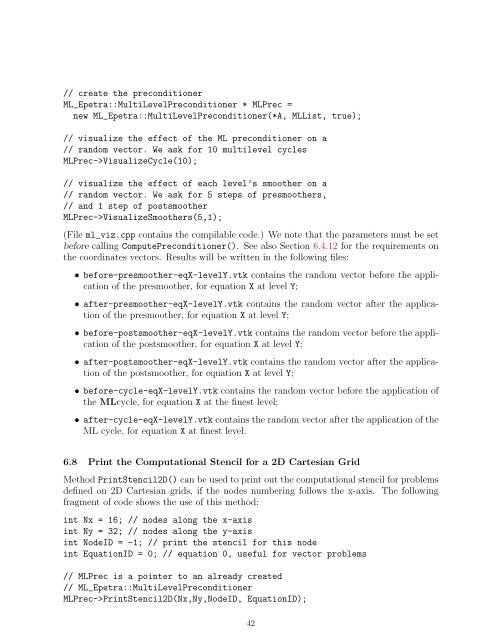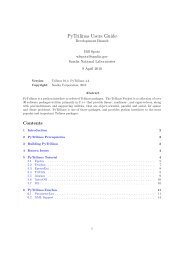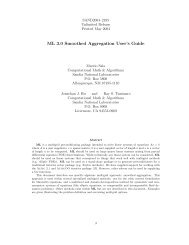nonsymmetric dynamics
ML 5.0 Smoothed Aggregation User's Guide - Trilinos - Sandia ...
ML 5.0 Smoothed Aggregation User's Guide - Trilinos - Sandia ...
- No tags were found...
You also want an ePaper? Increase the reach of your titles
YUMPU automatically turns print PDFs into web optimized ePapers that Google loves.
create the preconditioner<br />
ML_Epetra::MultiLevelPreconditioner * MLPrec =<br />
new ML_Epetra::MultiLevelPreconditioner(*A, MLList, true);<br />
// visualize the effect of the ML preconditioner on a<br />
// random vector. We ask for 10 multilevel cycles<br />
MLPrec->VisualizeCycle(10);<br />
// visualize the effect of each level’s smoother on a<br />
// random vector. We ask for 5 steps of presmoothers,<br />
// and 1 step of postsmoother<br />
MLPrec->VisualizeSmoothers(5,1);<br />
(File ml_viz.cpp contains the compilable code.) We note that the parameters must be set<br />
before calling ComputePreconditioner(). See also Section 6.4.12 for the requirements on<br />
the coordinates vectors. Results will be written in the following files:<br />
• before-presmoother-eqX-levelY.vtk contains the random vector before the application<br />
of the presmoother, for equation X at level Y;<br />
• after-presmoother-eqX-levelY.vtk contains the random vector after the application<br />
of the presmoother, for equation X at level Y;<br />
• before-postsmoother-eqX-levelY.vtk contains the random vector before the application<br />
of the postsmoother, for equation X at level Y;<br />
• after-postsmoother-eqX-levelY.vtk contains the random vector after the application<br />
of the postsmoother, for equation X at level Y;<br />
• before-cycle-eqX-levelY.vtk contains the random vector before the application of<br />
the MLcycle, for equation X at the finest level;<br />
• after-cycle-eqX-levelY.vtk contains the random vector after the application of the<br />
ML cycle, for equation X at finest level.<br />
6.8 Print the Computational Stencil for a 2D Cartesian Grid<br />
Method PrintStencil2D() can be used to print out the computational stencil for problems<br />
defined on 2D Cartesian grids, if the nodes numbering follows the x-axis. The following<br />
fragment of code shows the use of this method:<br />
int Nx = 16; // nodes along the x-axis<br />
int Ny = 32; // nodes along the y-axis<br />
int NodeID = -1; // print the stencil for this node<br />
int EquationID = 0; // equation 0, useful for vector problems<br />
// MLPrec is a pointer to an already created<br />
// ML_Epetra::MultiLevelPreconditioner<br />
MLPrec->PrintStencil2D(Nx,Ny,NodeID, EquationID);<br />
42







